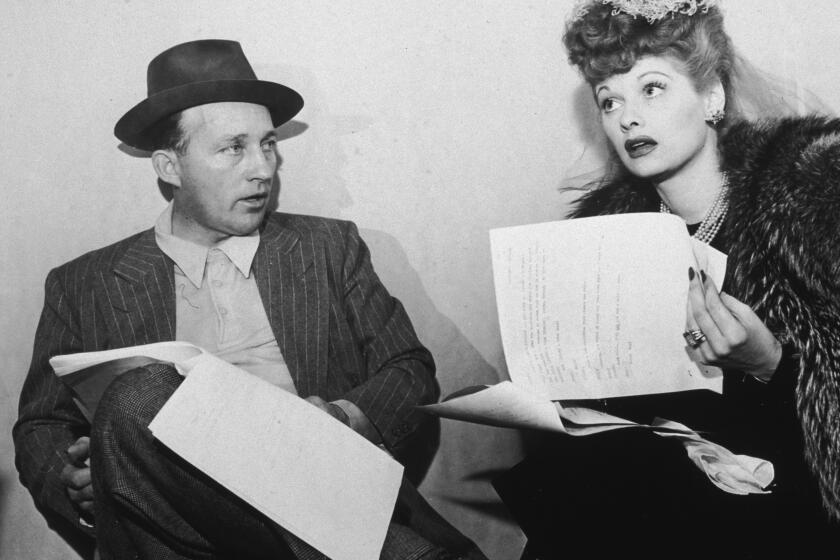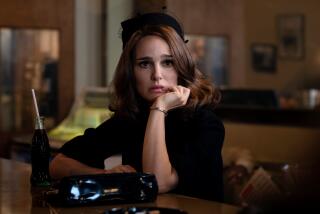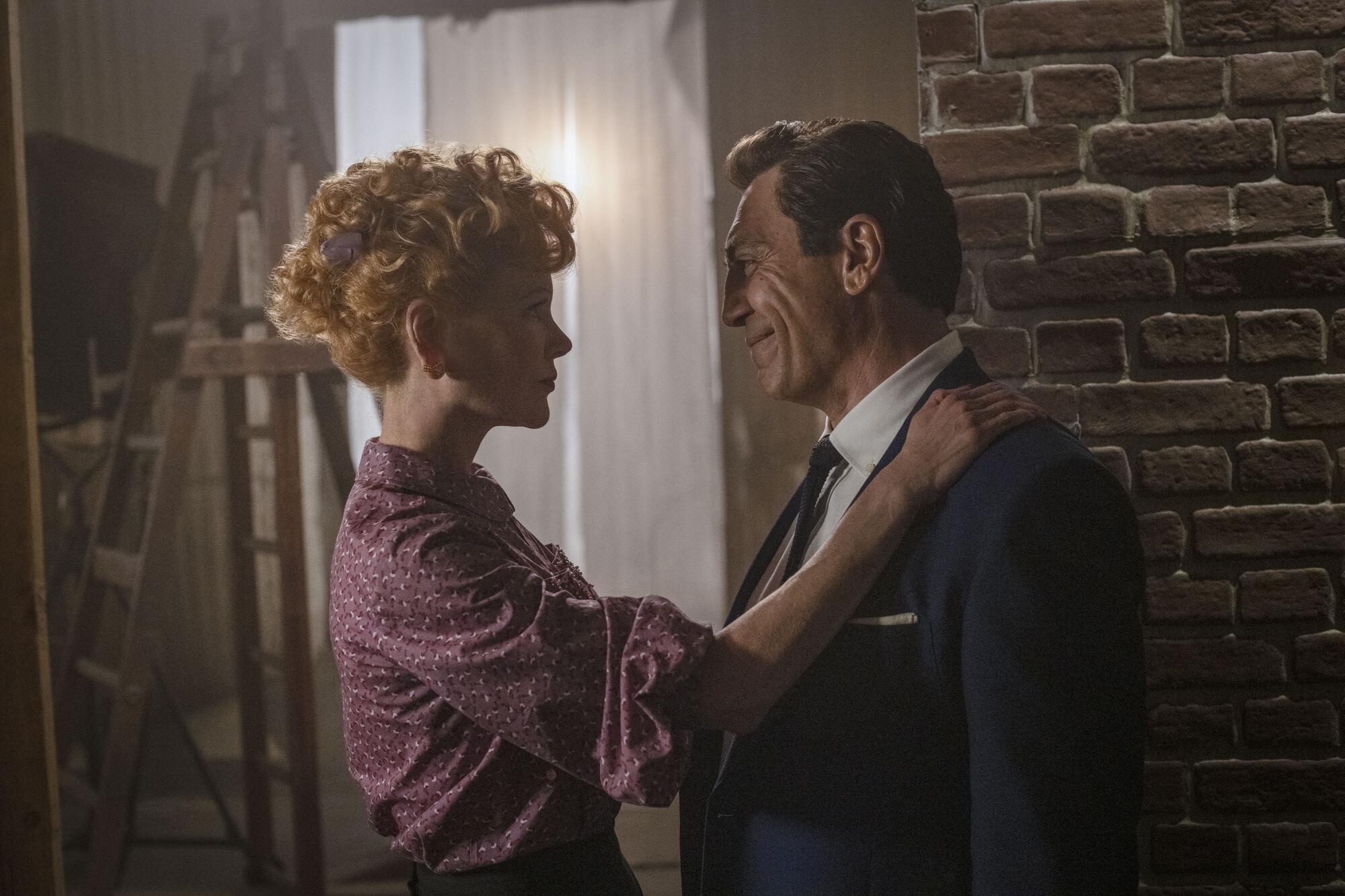
- Share via
Before you even see Nicole Kidman and Javier Bardem as TV’s most beloved husband and wife in “Being the Ricardos,” a biopic that follows the famous duo behind the classic “I Love Lucy” sitcom, you’ll hear them. The pair get a slow reveal as Lucille Ball and Desi Arnaz, respectively, in the opening moments of the film, midfight and purposefully in contrast to their black-and-white TV personas.
It’s the first sign that writer-director Aaron Sorkin is all too aware of the expectations most viewers — particularly Lucy-philes — will bring to a film about the incomparable zany redhead and her broad-shouldered Cuban bandleader husband that they’ve come to know through nearly 200 timeless episodes.
Although Kidman and Bardem have inhabited well-known figures before on-screen, both admit there was an especially high degree of difficulty in portraying one of Hollywood’s all-time great couples.
“When you’re playing someone that has done beautiful things for all of us, as an actor, you have a responsibility to honor that soul, that person,” Bardem says. “I’ve played Pablo Escobar, who is someone you don’t want to honor, who you want to really expose the evil within that can create so much damage around. But in playing someone like Desi, what you have to do is prepare yourself and read and watch as much as you can; see and get information. And then there’s a moment where you have to jump into the pool ... We are trying to grab what they meant for the business, what they meant for the world, what they meant for the audiences, what they meant for each other.”
For Kidman, who wasn’t an obvious choice to capture Ball’s physical comedy genius, the process of disappearing into the lovable funnywoman proved “daunting.” She spent six weeks studying the “I Love Lucy” catalog.
“I didn’t know an enormous amount about her,” says Kidman, who uses Ball’s full name, Lucille, when talking about her. “Aaron was like, ‘This is not meant to be some sort of carbon copy of “I Love Lucy”; you can go do whatever preparation you’re going to do for the “I Love Lucy” [stuff], but I’m interested in Lucy and Desi.’”
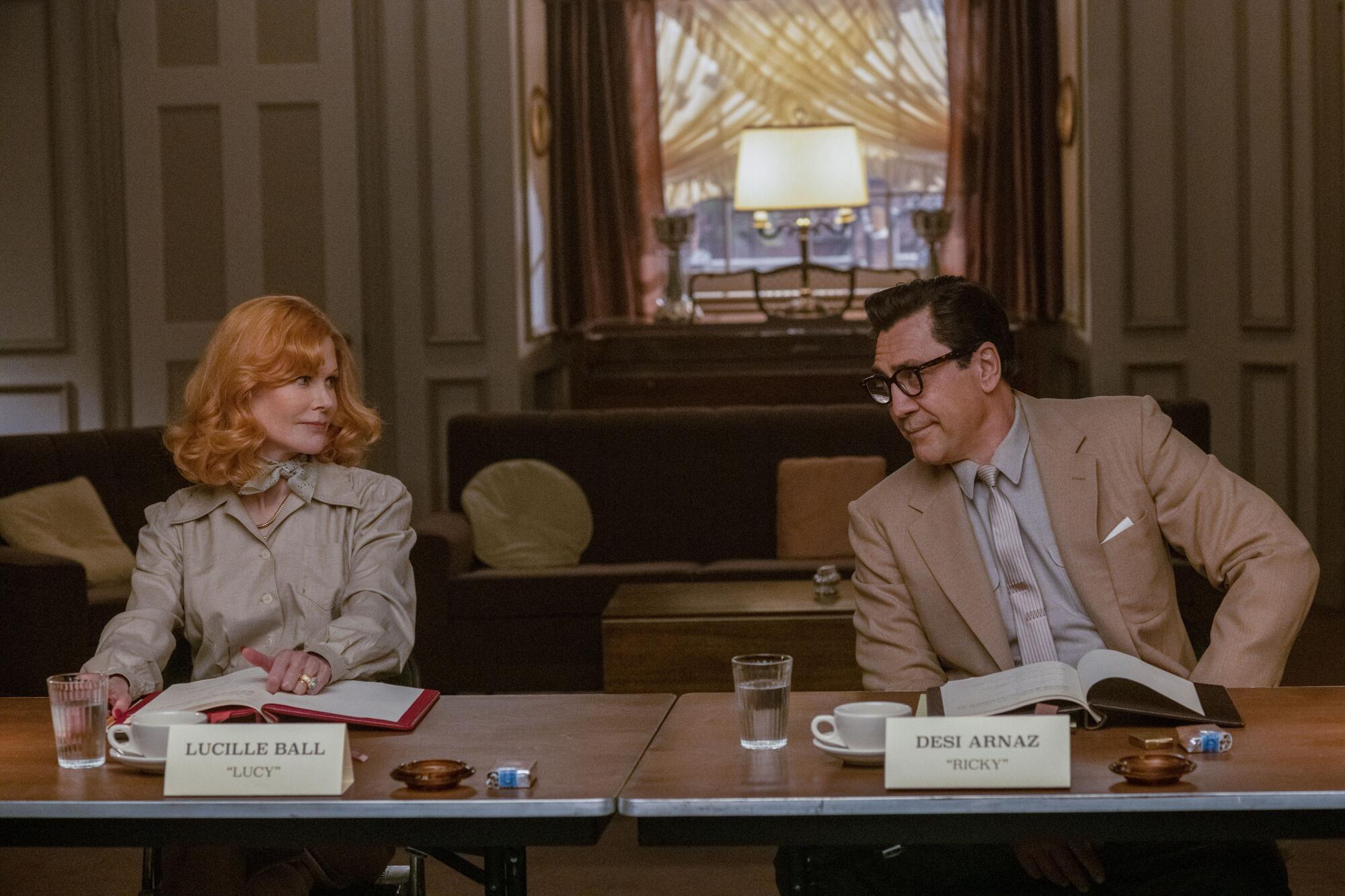
Even so, it took all of 11 minutes into the call before Kidman ditched the lilt of her Australian accent to demonstrate the ease with which she can now slip into her impression of Ball’s voice and that of her famous fictional alter ego, Lucy Ricardo.
“Lucille has a deeper voice, a voice that smokes a packet of cigarettes a day,” she says, turning it on. “And then the Lucy Ricardo is a very different timber. It was a really rigorous, technical approach.”
Prompting Bardem to chime in: “We worked our asses off to get as close as we could in order to really honor who they were physically, their behavior, their voice, their tone, their differences between who they were on the show and who they were behind the show.”
“Being the Ricardos” continues Sorkin’s penchant for telling behind-the-scenes stories exploring the tensions and grand themes that emerge in the making of extraordinary things. The film opens with the conceit that a documentary is being made about a chaotic week of production on “I Love Lucy” in 1952, in which a convergence of crises — including an investigation by the House Un-American Activities Committee into Ball’s alleged ties to communism — nearly brought down the wildly popular 1950s sitcom and deepened the cracks and strengths of Ball and Arnaz’s real-life marriage.
“It’s exploring marriage and the nature of building a company together in a creative union versus a romantic union, and how do you navigate that?” Kidman says of the film, which arrives Dec. 10 in theaters and Dec. 21 on Amazon Prime Video.
In a late-October conversation across multiple time zones — Kidman calling in from her home in Nashville, and Bardem from his home in Madrid — the duo talked about finding their way into the different sides of Lucy and Desi: their marriage in real life and reel life, as well as their business partnership.
MARRIED LIFE

Ball and Arnaz first crossed paths in 1940 at the commissary on the RKO lot in Culver City (ironically now the L.A.-area home of Amazon Studios); she was shooting the Dorothy Arzner-directed film “Dance, Girl, Dance” on a nearby soundstage, he was lunching with the Broadway cast of “Too Many Girls,” which the studio was going to adapt into a film musical that they would later star in together. They had dinner that night and their whirlwind, often turbulent, love story quickly took shape. They wed on Nov. 30, 1940, and were married for 20 years — not always happily.
Although their on-screen chemistry mirrored their real-life affection, things weren’t always so picture-perfect off-screen. Sorkin’s film spends time mining the intimate moments of their complex relationship — the way their respective careers kept them apart early in their relationship, Ball’s suspicions of Arnaz’s philandering, and the stress of running a business empire together.
“Something that Javier and I talked about is that this is a love story — this is about two people that, whatever the situations and the barriers and the things they’re up against, the underlying love has to shine through,” Kidman says. “I love how they handled their failures, separately and together. Each failure spurred them on. And I love that they had this kinetic energy — he saw her, what she was capable of, and he believed in her even when she didn’t believe in herself ... That’s so romantic, deeply loving.”
Bardem and Kidman didn’t have much time to develop their chemistry in the same room. They were cast at the height of the COVID-19 pandemic, relying on Zoom to connect, because they were isolating in different parts of the world. Helping add some assurance that their portrayals of the marriage felt truthful, Kidman says, was the involvement of Lucy and Desi’s daughter, Lucie Arnaz. As an executive producer, alongside her brother, Desi Arnaz Jr., Lucie had input on the casting and script, and she visited the set.
Breaking the hearts of millions of fans, Ball filed for divorce on March 3, 1960, while filming the series finale of “The Lucy-Desi Comedy Hour.” Bardem, who relied heavily on Arnaz’s 1976 memoir “A Book” for insight into the performer’s outlook, studied that episode, which closes with Edie Adams singing “That’s All.”
“You feel that they’re singing a song about love and you know that’s the very, very last episode of the series. And after that they divorced. It’s too heartbreaking even to talk about it, because it’s emotional.”
SCREEN LIFE
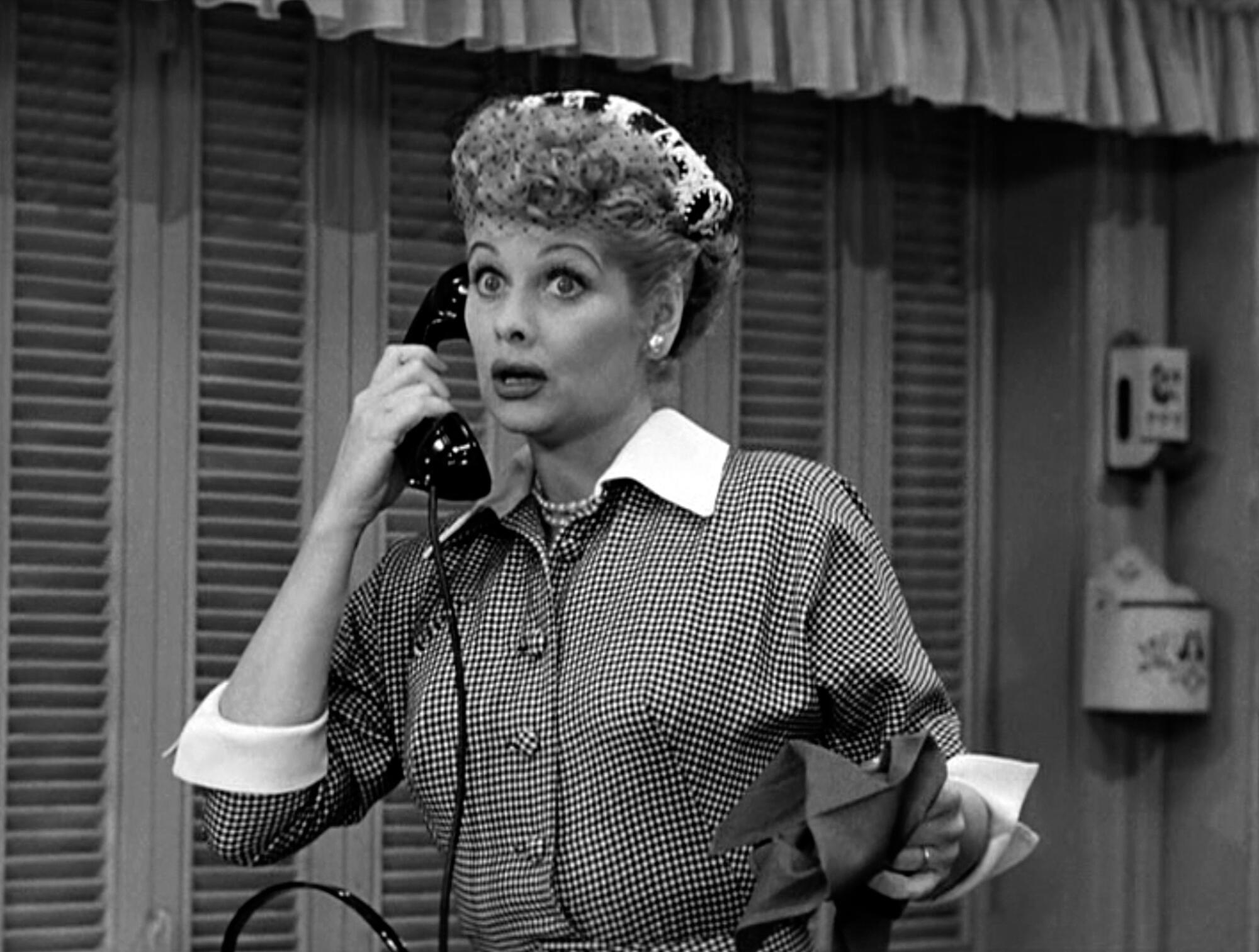
“Being the Ricardos” plops viewers into the height of “I Love Lucy’s” success, as the sitcom had a nation glued to their screens every Monday night — so much so that the popular Marshall Field’s department store closed early those evenings. Back then, when television consisted of a whopping four broadcast networks, the series consistently dominated the ratings.
“I Love Lucy” had its roots in the popular CBS radio show “My Favorite Husband,” which starred Ball opposite Richard Denning. When Ball was approached by CBS about adapting the show for television, the actress famously had to fight to get Arnaz cast as her TV husband; network brass feared the public wouldn’t warm to a mixed-ethnicity marriage on television. The network eventually relented.
The series lives on as the couple’s crowning achievement and one of TV’s greatest successes — seven decades later, few television comedies can rival its legacy. But “Being the Ricardos” is prudent with the amount of time spent re-creating specific moments from the sitcom.
The film mostly avoids the show’s most famous LOL moments — the chocolate factory conveyor belt madness and Vitameatavegamin — in favor of some of the less pop culturally ingrained shenanigans. The episode at the center of the documentary is “Fred and Ethel Fight,” in which Lucy schemes to reunite the Mertzes — played in the show by William Frawley and Vivian Vance and in the film by J.K. Simmons and Nina Arianda — by inviting them to dinner without either one knowing who the fourth guest is.

“We studied that episode so much,” Bardem says. “It became a different experience watching it, knowing how we tackle it. I saw it so many times. And then I realized the more I saw it, the more deep I got into their faces. The first time you see it, it’s like, ‘Oh, that’s funny.’ But then you realize: ‘That’s the ’50s. Look what they’re doing. They’re super advanced in their sense of humor. They are super fast. They have great dialogue. They have great timing. Every little movement and facial expression works together.’”
One hallmark bit does factor into “Being the Ricardos”: The famous grape-stomping sequence from the episode where Lucy is trying to get a part in an Italian movie.
Sorkin has the “I Love Lucy” scenes unfold as rehearsals or bouts of brainstorming, a move that gives distance and context to comedic perfection. And despite Sorkin’s initial assurance that he wasn’t interested in the “I Love Lucy” of it all overpowering the actors’ performances, Kidman felt nailing down Lucy Ricardo would help imbue her with the confidence to play Ball off-screen as well.
“I said, ‘OK, you’re not interested in a carbon copy of her — I get it.’ I don’t look like her. My frame is similar to her, my physical frame and my coloring, but there’s obviously different things,” Kidman says. “And so I said: ‘I’d be interested in trying to really photocopy Lucy Ricardo.’ With the grape scenes, I studied and studied and studied. Every single move, every single facial expression. It’s like learning a dance routine. We wanted to be incredibly accurate and spot on — Aaron was even like, ‘It doesn’t need to be exactly the same because the show gets edited and changed, this is rehearsal.’ But it was important to me. And in doing so, I had the best time and completely revere her genius.
“She has incredible clown qualities. When we were doing the grapes scene — I think we only did it three times, because we had limited time, but they had real grapes — I sort of jumped down and started swimming around in the grapes. [Aaron] didn’t have the wrestling part of the scene, where the two of us wrestle — that wasn’t the way Lucille was thinking about it — so I just sort of improvised with that. And that was just so freeing, it was fantastic.”
BUSINESS LIFE
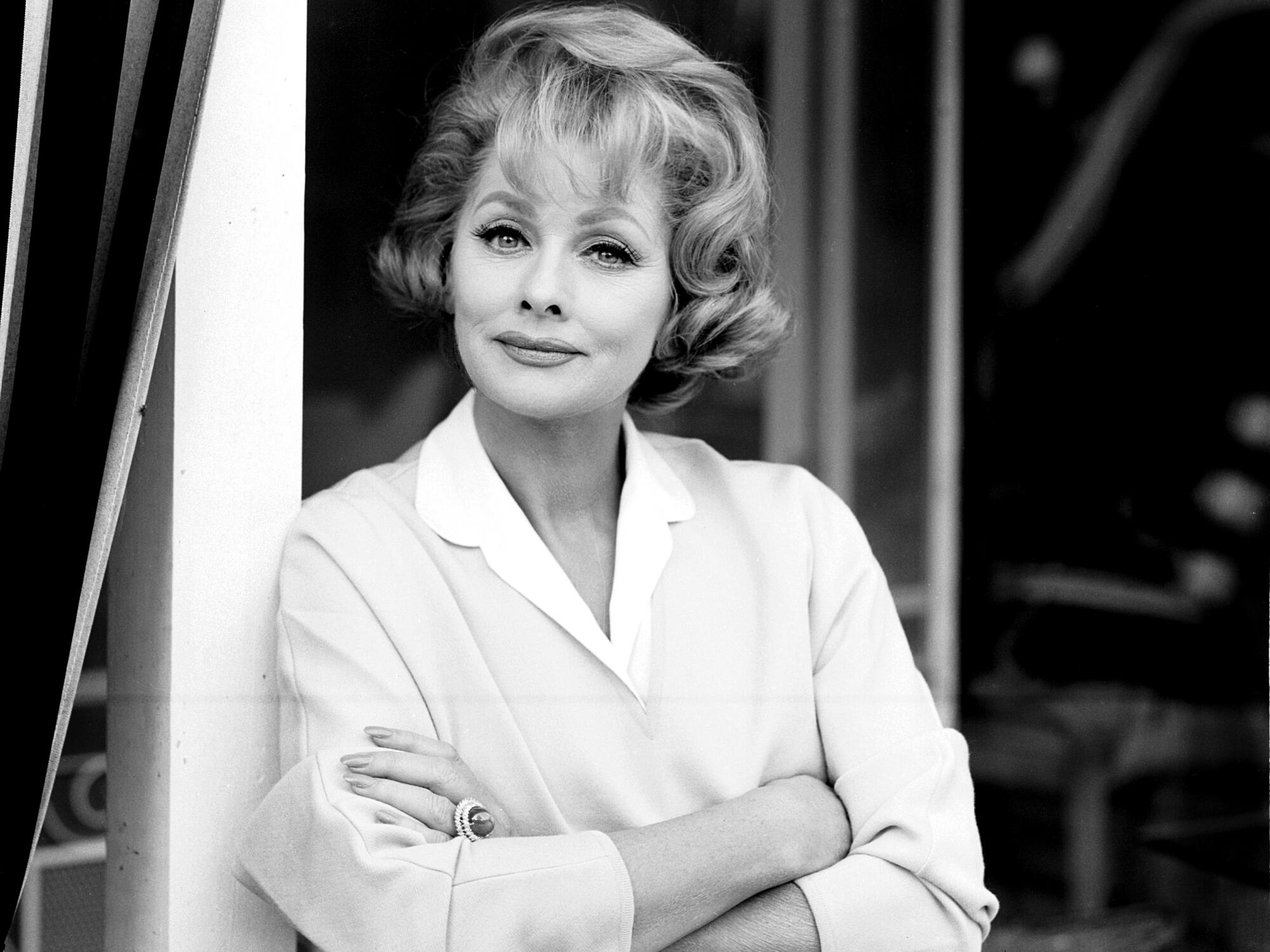
In telling the story of Ball and Arnaz, the film establishes their business savviness and immense contribution to the entertainment industry.
“I Love Lucy” was a hugely influential series that revolutionized the small screen as the first sitcom filmed with three cameras in front of a live audience. And Arnaz and Ball launched their own studio, Desilu Productions, that turned out such network hits as “The Untouchables,” “Mission: Impossible” and “Star Trek.”
“They were a great team,” Kidman says. “They had demons, they had passion, they had all those other things coming at them, but the basis of what they could achieve together as a creative team and as a couple was extraordinary. And really set the path for so many other people to follow.”
Bardem adds: “Lucille was very brave in going ahead with putting her husband near her at a time where that was absolutely denied by the society because he was an immigrant, and for giving him that space he deserved as a businessman. It seems like no big deal in hindsight. But it was. And [in the film,] you really get a sense of what Desi meant to the business of Hollywood.”
One of the dilemmas explored in the film is when Ball became pregnant with their second child, Desi Jr., in 1952. At the time, when on-screen married couples slept in separate beds, pregnancy was considered a taboo topic for the airwaves. Ever the trailblazer, Ball had her pregnancy written into the show — under the caveat that “expecting” would be used in place of the “P” word.
Forty-four million viewers tuned in to watch Lucy give birth to Little Ricky, which accounted for 72% of all TV homes at the time. (Ball gave birth to her son the same day Little Ricky was born.) Dwight D. Eisenhower’s presidential inauguration the previous day drew 29 million viewers.
“They were revolutionaries,” Bardem says.
That’s why we still love Lucy ... and Desi.
The ‘I Love Lucy’ star’s 1960s radio program is coming to SiriusXM and other streaming audio platforms.
More to Read
Only good movies
Get the Indie Focus newsletter, Mark Olsen's weekly guide to the world of cinema.
You may occasionally receive promotional content from the Los Angeles Times.
